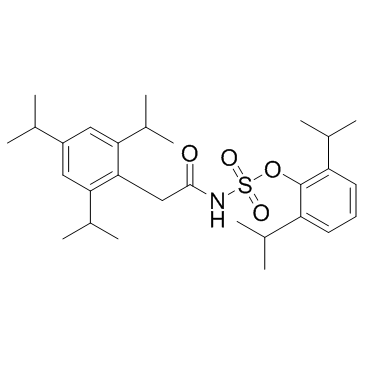Anti-atherogenic effects of the acyl-CoA:cholesterol acyltransferase inhibitor, avasimibe (CI-1011), in cultured primary human macrophages.
Annabelle Rodriguez, David C Usher
Index: Atherosclerosis 161(1) , 45-54, (2002)
Full Text: HTML
Abstract
Acyl-CoA:cholesterol acyltransferase (ACAT) inhibitors have been shown to reduce atherosclerotic lesions in animals; however, the mechanism(s) for this effect remains unclear. Therefore, we used cultured primary human monocyte-derived macrophages (HMMs) to examine the effect of the ACAT inhibitor, avasimibe (CI-1011), during foam cell formation and during cholesterol efflux from established foam cells. To examine the effect of CI-1011 on foam cell development, HMMs were incubated with aggregated acetylated LDL (ag-acLDL)+/-CI-1011 for 48 h. Total cholesterol (TC) was 29% lower in HMMs incubated with ag-acLDL and CI-1011 compared with ag-acLDL (P<0.05). To determine if TC reduction was due to reduced ag-acLDL uptake by CI-1011, 125I-acLDL binding at 4 degrees C for 4 h to HMMs preincubated with acLDL or ag-acLDL, CI-1011, acLDL+CI-1011, or ag-acLDL+CI-1011 for 48 h was measured. Specific binding was 40% lower in cells preincubated with acLDL+CI-1011, 52% lower in cells preincubated with ag-acLDL+CI-1011 and 49% lower in cells preincubated with CI-1011 compared with cells preincubated with acLDL (P<0.0003). Because CI-1011 appeared to directly affect acLDL binding, 125I-acLDL (3-80 microg protein/ml) binding was done in HMMs preincubated with CI-1011 (0-10 microg/ml) for 48 h. The calculated B(max) decreased in HMMs exposed to increasing concentrations of CI-1011, suggesting that CI-1011 altered scavenger receptor function and/or number. To examine the effects of CI-1011 on cholesterol efflux from established foam cells, we first examined whether CI-1011 was cytotoxic. HMMs were preincubated with ag-acLDL for 24 h, and then radiolabeled with [14C]adenine for 2 h (time zero). The radiolabeled cells were exposed to control RPMI medium or the same medium+HDL, CI-1011, or HDL+CI-1011 for 24 h. The release of [14C]adenine into the medium was not significantly different between cells exposed to RPMI, HDL, CI-1011, or HDL+CI-1011, suggesting that CI-1011 was not cytotoxic. Foam cells exposed to RPMI and CI-1011 (1-10 microg/ml) for 48 h showed time dependent reduction in cellular TC mass, with a corresponding increase in radiolabeled unesterified cholesterol into the medium. We then asked whether CI-1011 enhanced apoE mediated cholesterol efflux. Although cellular apoE increased between 2- and 7-fold in foam cells compared to control macrophages, apoE secreted into the medium was not significantly different between cells exposed to RPMI or CI-1011. Thus, CI-1011 exerted anti-atherogenic effects by reducing TC accumulation, inhibiting acLDL binding, and by limiting lipid storage in HMMs.
Related Compounds
| Structure | Name/CAS No. | Molecular Formula | Articles |
|---|---|---|---|
 |
Avasimibe
CAS:166518-60-1 |
C29H43NO4S |
|
Statin therapy alone and in combination with an acyl-CoA:cho...
2007-01-01 [Pathophysiol. Haemost. Thromb. 36(1) , 9-17, (2007)] |
|
Coronary circulatory function in patients with the metabolic...
2011-09-01 [J. Nucl. Med. 52(9) , 1369-77, (2011)] |
|
Avasimibe and atorvastatin synergistically reduce cholestery...
2002-09-06 [Eur. J. Pharmacol. 451(1) , 11-7, (2002)] |
|
Effects of avasimibe on cytochrome P450 2C9 expression in vi...
2004-12-01 [Drug Metab. Dispos. 32(12) , 1370-6, (2004)] |
|
New advances in lipid-modifying therapies for reducing cardi...
2002-01-01 [Cardiology 97(2) , 59-66, (2002)] |